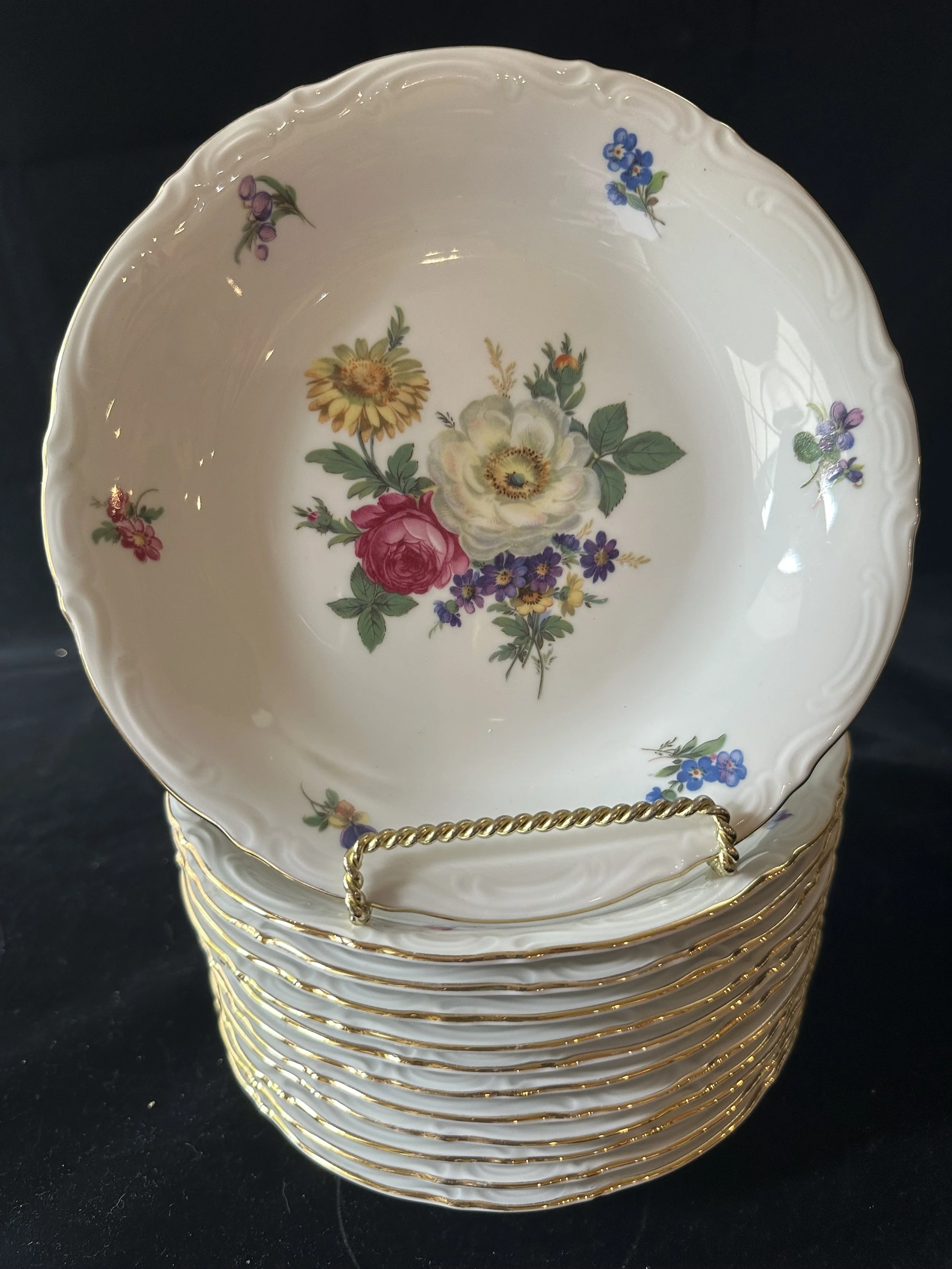The Meissen Floral Pattern
Mitterteich China: A Brief History
Mitterteich is a town in Bavaria (Germany) that became known for its porcelain and china production.
The factory was founded in 1887 by Ludwig Lindner
In 1895, it was taken over by Mosanic Pottery Max Emanuel & Co. from London.
Over time, it evolved its operations (with expansions in the 1920s and ’30s), producing a wide range of domestic porcelain goods.
The factory marked many of its pieces “Bavaria,” which signifies the region, well known for high quality porcelain.
The factory eventually ceased independent operations. According to various sources, production under the original Mitterteich name ended, and many patterns, especially popular ones, are now discontinued.
So Mitterteich holds a place among the many German porcelain manufacturers who combined craftsmanship with decorative beauty, especially during the first half to mid-20th century.
The Meissen Floral Pattern
“Meissen Floral” is one of Mitterteich’s more recognizable patterns. Despite the name, it’s important to clarify what “Meissen” refers to in this context.
Name vs. Origin: The word “Meissen” in this pattern name does not imply that the china was made by the historic Meissen porcelain manufactory in Saxony (the famous one). Rather, in Mitterteich’s pattern naming, “Meissen Floral” describes a style: abundant multicolored flowers arranged in a central bouquet, often with smaller sprigs or flowers decorating the rim. It’s a fairly common naming convention in porcelain / china to use “Meissen” as a descriptor of style, perhaps inspired by or evocative of high-end floral porcelain.
Design Elements:
A large floral bouquet in the center (often roses, garden flowers) in soft, rich colors.
Scalloped or gently ornate rims, frequently with small individual flowers or buds spaced around the rim.
Gilding is common, especially along edges. It adds a touch of elegance.
Period: The pattern was produced in the mid-20th century and is now discontinued.
So Meissen Floral pieces are vintage rather than contemporary, with popularity stemming from their classic, feminine, decorative appeal.
Appeal & What Makes Meissen Floral Special
Why do people love the Meissen Floral pattern by Mitterteich? Here are some of the draws:
Romantic Floral Aesthetic
The central bouquet + decorative rim combo evokes a traditional, almost nostalgic feeling. It plays well in vintage, country, Victorian, shabby-chic, or even “English garden”-inspired décor.Color Palette
The colors are typically balanced — not overly gaudy, but rich enough to stand out. Whites, pinks, yellows, greens, lavenders — real garden tones.Craftsmanship & Origin
Porcelain from Bavaria has a reputation for good quality. Even though Mitterteich china isn’t the same as high-end Meissen, it carries weight among collectors for its heritage and durability.Versatility
Because of its decorative yet classic style, Meissen Floral works both in display cases and in use. It offers elegance for special occasions, yet its size and availability (in vintage markets) make it possible to assemble partial or full sets without the astronomical costs of very high-end china.Collectibility & Nostalgia
Many people collect pieces like this because of nostalgia (family pieces, inherited sets), or love for vintage tableware. Discontinued patterns tend to become more valuable (or at least more desired) with time.
Things to Know / Collectors’ Tips
If you’re interested in Meissen Floral by Mitterteich (or similar vintage china), here are some tips:
Marks & Backstamps:
Look for the “Mitterteich Bavaria Germany” stamp, sometimes with pattern codes. These help verify age and authenticity. Also note gold trim wear (common with use).Condition:
Because of the gilding and delicate painting, pieces may have wear, crazing (fine cracks in glaze), or slight chips. For display, this may be acceptable; for dining use, you'd want better condition.Matching & Completeness:
Full sets are rare; more common are individual plates, serving pieces, cups, etc. Sets often mix in “rims” or “accent pieces.” If you’re building a set, check proportions (size of dinner plate vs. salad plate, etc.).Price Range:
Prices depend on piece type (platter vs. tea cup vs. dinner plate), rarity, condition. Discontinued status tends to increase demand. Good deals are often found in antique shops, online vintage stores, or auctions.Maintenance:
Hand wash whenever possible, avoid harsh abrasives, avoid dishwashers (especially for gold trim). Store carefully to avoid scratches.Authenticity of “Meissen” Name:
Again, the pattern name “Meissen Floral” doesn’t mean it was made by the Meissen manufactory. If someone claims otherwise, verify by mark, historical record. Many vintage pieces will clearly state “Mitterteich.” Pure Meissen (Saxon) porcelain usually has different quality and distinct marks.
